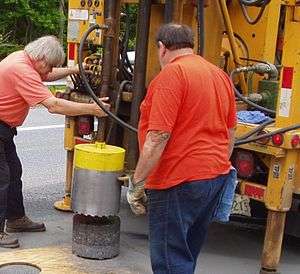Core drill

A core drill is a drill specifically designed to remove a cylinder of material, much like a hole saw. The material left inside the drill bit is referred to as the core.
Core drills used in metal are called annular cutters. Core drills used for concrete are generally called Diamond Core Drills and are water cooled.[1] For drilling masonry, carbide core drills can be used.[2]
The earliest core drills were those used by the ancient Egyptians, invented in 3000 BC.[3] Core drills are used for many applications, either where the core needs to be preserved (the drilling apparatus used in obtaining a core sample is often referred to as a corer), or where drilling can be done more rapidly since much less material needs to be removed than with a standard bit. This is the reason that diamond-tipped core drills are commonly used in construction to create holes for pipes, manholes, and other large-diameter penetrations in concrete or stone.
Core drills are used frequently in mineral exploration where the coring may be several hundred to several thousand feet in length. The core samples are recovered and examined by geologists for mineral percentages and stratigraphic contact points. This gives exploration companies the information necessary to begin or abandon mining operations in a particular area.
Before the start of World War Two, Branner Newsom, a California mining engineer, invented a core drill that could take out large diameter cores up to 16 feet in length for mining shafts. This type of core drill is no longer in use as modern drill technology allows standard drilling to accomplish the same at a much cheaper cost.[4]
Core drills come with several power choices including electric, pneumatic, hydraulic (all of which require power sources, such as a generator).
See also
- Core drills (annular cutters for metal drilling)
- Drilling fluid
- Drilling rig
- Exploration diamond drilling
References
- ↑ "Diamond Core Bits vs Carbide Core Bits". Retrieved 4 August 2014.
- ↑ "Concrete Drilling Tutorial". Retrieved 4 August 2014.
- ↑ Jacques W. Delleur (12 December 2010). The Handbook of Groundwater Engineering, Second Edition. Taylor & Francis. p. 7 in chapter 2. ISBN 978-0-8493-4316-2.
- ↑ Boone, Andrew R. (December 1943). "He Bores Bigger Holes". Popular Science: 104–107.